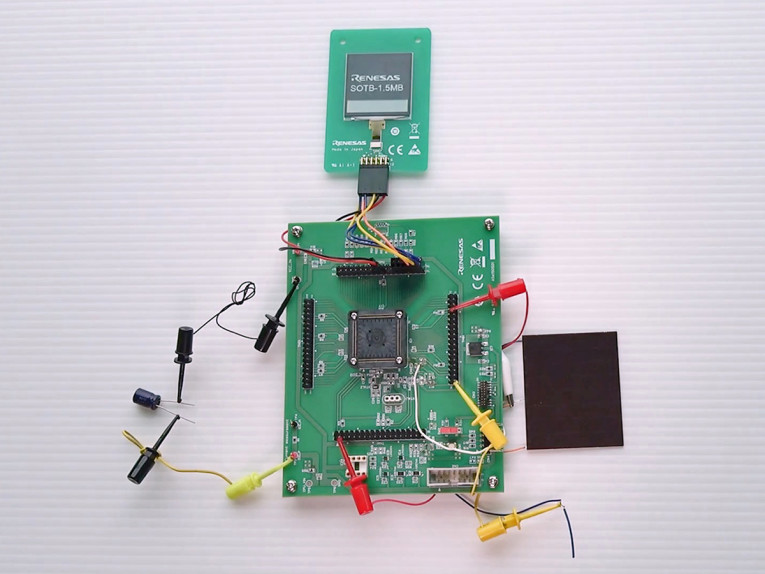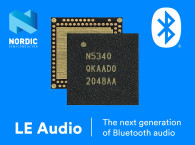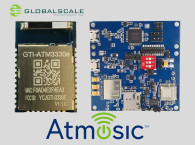
These extreme low current levels of the SOTB-based embedded controller enables system manufacturers to take a step further and completely eliminate the need for batteries in some of their products through harvesting ambient energy sources such as light, vibration, and flow. The use of extreme low-power and energy harvesting gives rise to a new market of maintenance-free connected IoT sensing devices with endpoint intelligence for all types of applications, including wearables, smart watches, and earbuds. Renesas has already begun supplying the new embedded controller to beta customers.
Renesas’ first commercial product using SOTB technology, the R7F0E embedded controller, is a 32-bit, ARM Cortex-based embedded controller capable of operating up to 64 MHz for rapid local processing of sensor data and execution of complex analysis and control functions. Consuming just 20 μA/MHz active current, and only 150 nA deep standby current, approximately one-tenth that of conventional low-power MCUs, these industry-leading characteristics make the R7F0E perfectly suited for extreme low-power and energy harvesting applications.
The R7F0E eliminates many challenges faced by system designers who want to build cost-effective products with efficient energy harvesting capabilities. There is a unique and configurable Energy Harvest Controller (EHC) function that increases robustness and minimizes costly external components. The EHC enables direct connection to many different types of ambient energy sources, such as solar, vibration, or piezoelectric, while protecting against harmful inrush current at start-up. The EHC also manages the charging of external power storage devices such as supercapacitors or optional rechargeable batteries. Many other system considerations for extreme low power are addressed by the R7F0E. Three such examples include the ability to sense and capture external analog signals at all times because the 14-bit Analog-to-Digital Converter (ADC) consumes only 3 uA current; to retain up to 256 KB of SRAM data content while consuming just one nA per each KB of SRAM; and to provide graphics data conversion including rotation, scroll, and colorization by incorporating sophisticated low-power hardware techniques for driving an external display using Memory-In-Pixel LCD technology that consumes virtually no power to retain an image.

These few examples represent the attention to detail that designers of the R7F0E had in mind to accommodate the needs of engineers who must consider overall system requirements for extreme low power designs.
“I am very pleased that Renesas achieved this milestone to productize our SOTB technology into a first-of-its-kind solution in the energy harvesting market,” says Yoshikazu Yokota, Executive Vice President and General Manager of Industrial Solution Business Unit of Renesas. "By removing the need for batteries, or the need to replace batteries, new markets will open for us and our customers. Energy harvesting will become a mandatory technology for a smart society and Renesas is poised to lead and expand this technology, and this market. Renesas continues to push forward with e-AI to realize AI at the endpoint, in embedded devices. Looking forward, our SOTB technology will expand our reach into use cases where combining e-AI and energy harvesting will make a very large positive impact to our day-to-day lives."

The unique SOTB process technology originated by Renesas realizes extreme reduction of both active and standby current, which has typically been a trade-off and is not possible to achieve in conventional MCU process technologies. On the silicon substrate, an oxide film (BOX: buried oxide) is buried under a thin silicon layer on the wafer substrate. No impurities are doped to the thin silicon layer which makes it possible to maintain stable operation at low voltages. The devices can therefore deliver high computing performance with excellent power efficiency. At the same time, the potential of the silicon substrate below the BOX layer is controlled with a back-bias circuit to reduce leakage currents to further suppress standby power consumption.
Samples of the new R7F0E embedded controller are available now for beta customers, and samples are scheduled to be available for general customers from July 2019. Mass production is scheduled to start from October 2019.
Click here for more information on the new R7F0E embedded controller.
www.renesas.com






